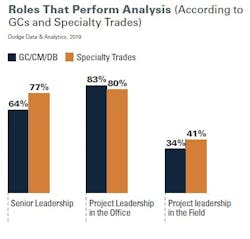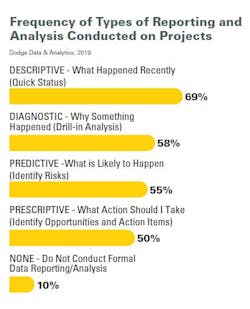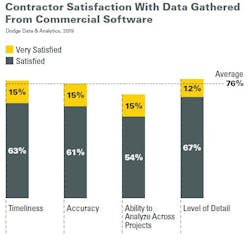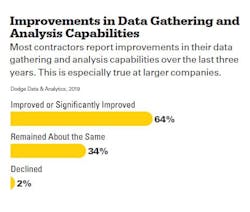There is a data transformation occurring in the construction industry as emerging technologies and solutions are empowering contractors to collect increased detail on their projects—and do more with this information. These technologies are changing the very way contractors across all disciplines operate, leading to smarter, safer construction projects and higher profit margins.
As technology has advanced in recent years, the construction industry has moved from one that resisted change to one that is embracing it. It’s no secret that contractors have become more tech-savvy, with data-driven professionals taking leadership roles within the business. The industry as a whole has seen firms transition from manual formats like paper and email to more streamlined, digitized processes, and moving from outdated software systems, many which are not designed for construction, to end-to-end, construction-specific, integrated software platforms that process data in real-time.
Today, contractors that specialize in grading, excavation, paving, or other work that can often involve remote locations and dispersed teams need a connected and collaborative approach. This approach includes working with up-to-date information flows that enable seamless communication among team members—whether in the back office, the job trailer, or out in the field.
Data Driving Modern Construction
The focus now is on how to improve the quality of data collected and better evaluating it to make smarter project and business decisions. This data intelligence revolution represents the next step in the construction industry’s tech-aided metamorphosis. As projects become larger and more complex, the need to better leverage data has become a priority, as a report from Dodge Data & Analytics and Viewpoint earlier this year notes. The report, titled Improving Performance with Project Data, looked at how data was currently being collected, stored, analyzed, and used among contractors, as well as what the next few years might hold.
Nearly two-thirds (64%) of contractors said their data gathering and analysis capabilities on construction projects had improved in the last three years. And that had a direct impact on the projects themselves as stronger, more current data drove better results. More than half (53%) noted improved ability to complete projects at or under budget; nearly half (47%) experienced improved productivity; more than one-third (35%) reported improved ability to complete projects met or exceeded schedule; and 34% experienced increased project safety.
Overall business benefits were also gained, with 46% reporting that greater profitability is one of the top three benefits they experience, and more than one quarter (26%) highlighting their improved ability to win new business. Here are some other key highlights from the report:
Commercial Construction Software is the Preferred Way to Collect and Analyze Data: Construction-specific management software or ERP platforms are now the preferred way to collect, parse, and analyze data, with an average of 76% of contractors either satisfied or very satisfied with these solutions. Conversely, the report also notes that while there is still some reliance on more manual methods like spreadsheets, less than half of contractors are content with this approach.
Project Financials Remain Top-Generated Report: Of the standard data reports available via construction software solutions, project financials are still the most commonly used (93%). Also noted among top reports by contractors were project logs (83%), safety reports (73%), and equipment maintenance and costs (52%). It’s a clear statement that costs and productivity are of chief importance for contractors.
The Role of Data Analysis is Moving Beyond Senior Leadership: More and more, project leaders in the office and the field are taking on the role of analyzing project information and making key decisions. As technologies and software become more accessible and intuitive, it is becoming easier for project stakeholders at all levels to be able to analyze data in formats that are relevant to them and their specific roles. As many as 34% of general contractors and 41% of specialty contractors are now performing some form of data analysis while in the field.
Majority of Contractors are Looking at Data to Predict Future Events: More than half of contractors (55%) noted they are looking at data in some form of predictive modeling, leveraging information to help them better understand trends, when and where future events or triggers will occur, and how to better plan for them.
Diving Deeper into Data
Data analytics, while driving the industry’s current data transformation, is not a new field of study. Businesses in all industries across the globe have used tools and strategies to look at the data they produce for decades now. In construction, that largely meant things like daily, weekly, or monthly project progress reports; baseline job cost reports as phases of projects were completed; or companywide labor, payroll, and productivity reports to compare one job to another and more.
However, the combination of powerful analytics tools with cloud accessibility and mobile connectivity are the ideal ingredients for today’s transformation, giving contractors the tools to make smarter, real-time decisions and automate workflows and processes.
These modern data analytic solutions and strategies are often grouped under “business intelligence” solutions, or “BI,” for short. BI focuses on the intelligent reporting and presentation of existing data to help make decisions based on past and present performance. Once a contractor commits to improving their treatment and use of business data, one of the first realizations is how much data is missing, duplicative, or just plain wrong. Step one of any approach to BI is to ensure the capture of accurate, timely, and complete data. Implementing modern software with integrated BI solutions can quickly point out the data gaps—where contractors are missing key information and where they are hitting the manual speed bumps due to late, inaccessible, or duplicated data entry into multiple, disconnected systems.
These gaps in data, coupled with burdensome manual processes, are root causes of consistent project challenges contractors have historically faced. Untimely, inaccurate data can make it hard to make the right project decisions when they’re needed most. Often, lack of current data and information leads to costly mistakes being made, like using the wrong materials or missing a key step in the construction process.
The Construction Industry Institute recently noted that unnecessary rework due to project errors accounted for up to 20% of a project’s contract amount. Even if rework were just 5% of total expenditures in the construction industry, that’s still a staggering $62 billion in lost revenue—revenue that could be recaptured through integrated business intelligence.
Being able to better analyze current project data and identify potential issues before they occur can have a significant impact on contractors’ bottom lines. That’s where today’s cloud-based, integrated construction management solutions come into play.
A Case for the Cloud
Many contractors have already improved processes by moving to more streamlined software solutions and removing manual, labor-intensive processes from their daily operations. Now they are looking to take this digitization to the next level by using leading-edge cloud technologies and solutions to collect, store, segment, and analyze data to better understand their projects and organizational health.
Operating in the cloud allows contractors to leverage modern technologies to improve data capture in the field. Among these:
The Internet of Things, or IoT: the connection of devices of all types to the Internet, providing for some degree of monitoring and control. From equipment meters and sensors that deliver real-time data to virtual geofencing solutions to protect job site assets or control labor rates, if a device can be connected to the internet, it can pull data into a connected data management platform.
Drones: Several contractors are already using drone-based systems to perform regular 3D scans of the work in progress to compare against the original 3D design plans, delivering very accurate estimates of a contractor’s percent completion on a project.
Special Purpose Sensors: Increasingly, internet-connected sensors are available for job site use. From basic temperature and pressure readings to the monitoring of vital signs through digitally-enabled PPE gear, these tools collect data to help keep workers safe and healthy.
The data flowing between the field, the office, and the extended project teams through interconnected, cloud-enabled software and mobile devices is seamless. This means that a contractor specializing in grading and excavating, for instance, can:
- Pull the very latest job cost or time and materials information in minutes rather than waiting days, weeks, or even months;
- Get up-to-the-minute material or load counts and inventory to get ahead of material costs or plan for different phases or weather concerns;
- Identify potential problems before they occur to prevent needless expenditures or rework;
- Ensure the right teams are assigned to the right projects at the right times to maximize labor productivity;
- Streamline and automate workflows, reducing hours of manual data entry and analysis, and much more
“We’re able to get a lot more granular information now,” says Howard Dembs, CFO with W. Soule in a recent case study. The company is using business intelligence features within Viewpoint’s cloud-based Spectrum construction ERP. “With the dashboards, we can look at stuff at a glance now, whereas before we had to work hard to drill into information and run reports.”
Scaling Success
While the advantages that cloud technologies bring to the table are empowering contractors to do more with the mountains of data they generate today, the cloud is also enabling contractors to better scale for tomorrow. The next wave of construction operations will be powered by detailed predictive and business analytic solutions, robotics and process automation, artificial intelligence, and machine learning (imagine programming your heavy equipment with a set of instructions and location and letting them self-perform the grading of an entire job site). These innovations are already being implemented today thanks to the pairing of the cloud with construction data and technology.
Business analytics, for example, applies algorithms to data to predict project and business performance with time to mitigate the risk. Business analysis solutions find previously unknown data relationships to help guide future business decisions.
These predictive analytics tools can spot trends and better forecast what might happen with future work. Good use of predictive analytics is in the area of profit fade, which has been an ongoing challenge in construction. By comparing current and historical cash flow data with other data like equipment usage metrics, labor and material costs, and productivity metrics, contractors can predict if there will be profit fade with time to mitigate and possibly reverse the trend.
Perhaps the best part is that contractors don’t need a team of advanced data scientists or hours upon hours of labor-intensive work to get to this level of insight. Powerful, construction-specific, cloud-based software with integrated data intelligence is doing the heavy lifting. Thanks to automated data collection and analysis processes, end-users can largely plug-and-play, easily moving information between data cubes or running advanced data queries in a few clicks.
It’s akin to running an advanced simulation to show how both projects and cash flow will look if workflows, costs, productivity rates, and more stay at current levels or if they’ve improved. And predictive analytics tools can also help identify where gaps or shortcomings might exist, allowing contractors to better plan ahead, ultimately producing more efficient, higher quality projects—and ultimately win more work.
“This data evolution is going to be transformational for the construction industry,” says Vice President Meggan Krase with Kansas City, MO-based Garney Construction, which has been working with Viewpoint to field test our new Viewpoint Analytics solution. “Being able to have predictive capabilities for-profit fade, safety, and other needs will have a significant impact on our company’s operations and the construction industry as a whole.”
Modern data intelligence solutions integrate industry benchmarks to assist contractors in comparing themselves against their peers and determine where they are outperforming the industry and where they are underperforming. This is critical in determining business focus—should you double-down on areas where one exceeds one’s peers, or focus on the underperforming areas to increase the overall margins of the business overall? Benchmarking is a simple concept yet a powerful tool in the BI arsenal.
A recent example of this comes from a heavy highway contractor in the Southeast with significant capital investment in heavy equipment. A reduction of just 1% in fleet costs would translate to a six-figure improvement to the bottom line, so it was worth the time to them to take a fine-tooth comb to the historic owning and operating costs of every machine in their fleet. BI benchmarking shone a light on the fact that, like many contractors, they were utilizing many machines well past the point of diminishing marginal returns—well past the time when it would have made more sense to rent out or just replace them. By deciding to combine information on equipment finance, operations, and utility time and benchmark against historical measures, this contractor was able to realize those six-figure cost savings.
Today’s leading-edge contractors are realizing the power that true data intelligence can bring to the table today. And this is only the tip of the iceberg. As technologies continue to advance, data will continue to be harnessed in new ways, and the contractors that have the technology in place to easily scale for these innovations will be poised to streamline construction productivity, increase profitability, and expand possibilities.
Matt Harris is Chief Product and Strategy Officer at Portland, OR-based company Viewpoint. He is responsible for drivingViewpoint’s overall product strategy and roadmap, ensuring they address the real-world business issues that construction professionals face every day.















